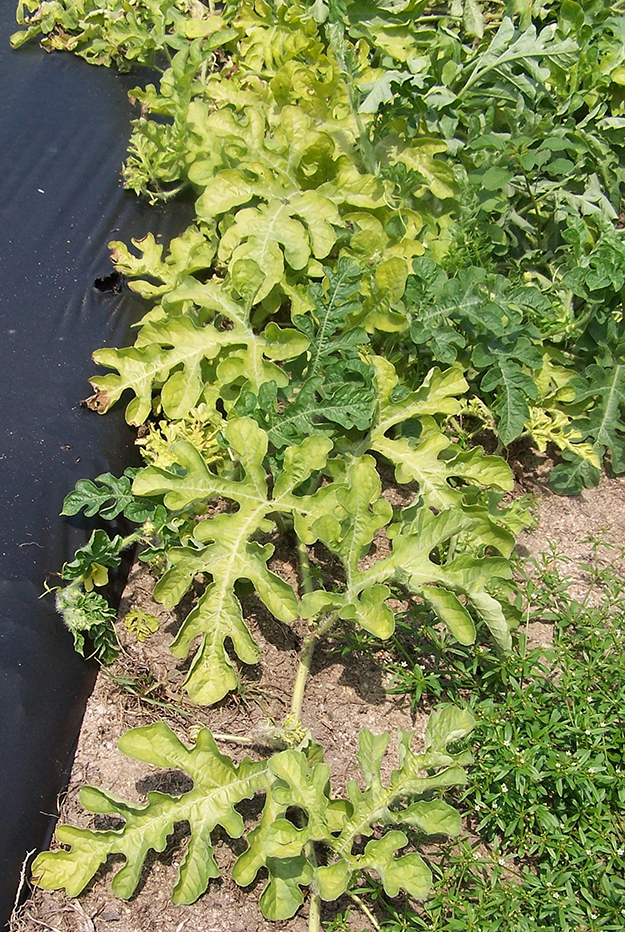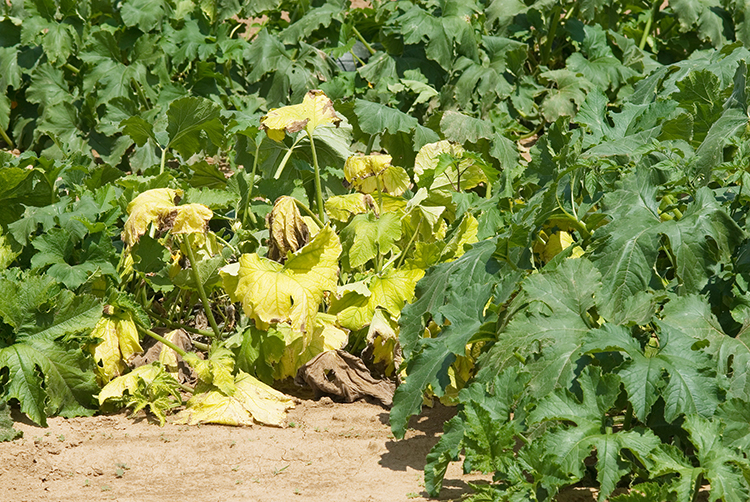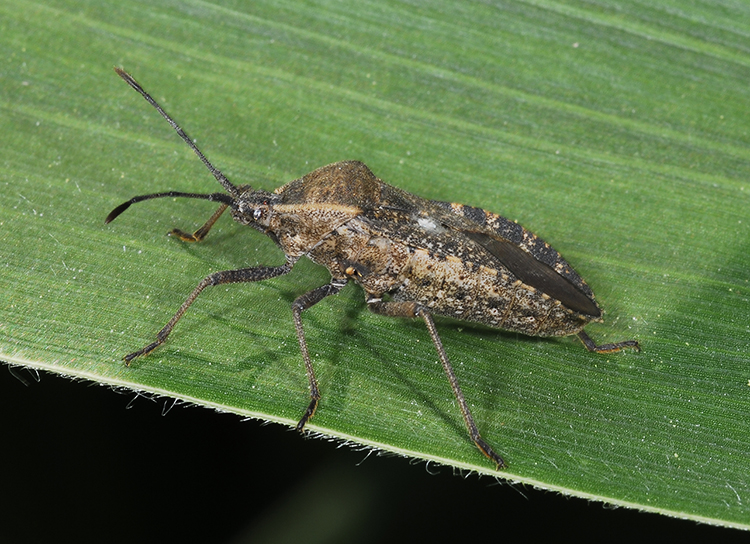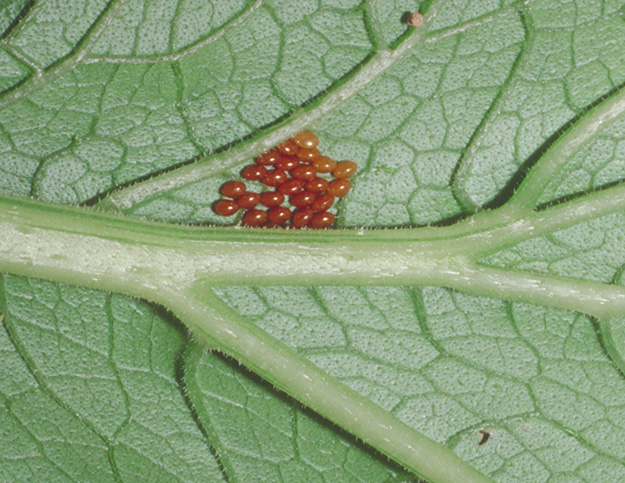Yellow Vine Decline of Cucurbits (PPFS-VG-12)
Download PDF
Nicole Gauthier, Plant Pathology Extension Specialist Ric Bessin, Entomology Extension Specialist
Importance
Yellow vine decline (YVD) is uncommon during most production years in Kentucky; however, occasionally heavy losses may occur. Susceptible cucurbits include squash, pumpkin, watermelon, and muskmelon (cantaloupe). It is not known to affect cultivated cucumber.
Symptoms
Yellow vine decline infections generally occur when plants are young, but symptoms are delayed until approximately 2 weeks before fruit maturity. Foliage suddenly turns an intense yellow, followed by plant collapse. (Figures 1 & 2). In some situations, immature plants may abruptly collapse with no other symptoms. Vascular tissue (phloem) from crowns of affected plants appears light brown rather than a healthy translucent green. YVD symptoms can be variable due to differences in plant species and age of plant at the time of infection, making diagnosis difficult. Additionally, YVD may be confused with other diseases (see next section). Secondary invasion of roots and lower stems by other pathogens can further complicate field diagnosis. Accurate diagnosis requires that plants are in the yellowing stage (with roots and vines still attached). Samples should be submitted to a local county Extension office. County Extension agents will facilitate sample submission to the University of Kentucky Plant Disease Diagnostic Laboratory.


Look-alikes
YVD can be confused with other problems affecting cucurbits.
Bacterial wilt – Stems affected by bacterial wilt exude a slimy sticky ooze from cut stems, while YVD does not produce ooze. The bacterial wilt pathogen is transmitted by cucumber beetle feeding activity, and these insects may be observed in affected plantings. Cucumber and muskmelon (cantaloupe) are highly susceptible to bacterial wilt; squash and pumpkin are less susceptible, and watermelon is resistant.
Fusarium wilt – Symptom development of Fusarium wilt is gradual, unlike the more rapid decline of plants affected by YVD. A reddish-brown discoloration of the xylem develops in stems in contrast to the lighter brown discoloration of phloem affected by YVD.
Squash vine borer – The presence of holes at the base of plants, along with frass, are tell-tale signs of squash vine borer activity. Cutting stems open will often reveal the presence of squash vine borer larvae within.
Cause & Disease Development
Yellow vine decline is caused by the bacterium Serratia marcescens and vectored (carried from plant to plant) by the squash bug (Anasa tristis).
The pathogen
Serratia marcescens overwinters in adult squash bugs. The pathogen is then introduced into young cucurbits in spring when adult squash bugs begin to feed and suck sap from the plant’s phloem. Once the bacterium invades the phloem, it multiplies and colonizes vascular tissue.
The vector
Squash bugs overwinter as adults in sheltered sites, such as under plant debris or rocks. Adults, which are brown and about an inch in length (Figure 3A), emerge and move into fields in late May and early June. While feeding on lower stems of newly set plants, adult squash bugs deposit the YVD bacterium via their piercingsucking mouthparts. In addition, these bugs can cause direct damage to stems through feeding activity. Adult bugs lay bronze-colored, football-shaped eggs (Figure 3B) in groups of 12 or more; eggs hatch within 1 to 2 weeks. Initially, nymphs are dark with a light green abdomen, but they become light gray in color with black legs as they mature (Figure 3C). Nymphs, which can also transmit the YVD bacterium, feed together in groups and require 5 to 6 weeks to mature into adults.



Disease Management
Effective control of YVD is completely dependent on eliminating squash bugs beginning at crop emergence or transplanting. Early insecticide sprays should target overwintering adults on young plants. Squash bugs can be difficult to control in mid- and late summer if populations are allowed to build up.
- Apply insecticides as soon as plants are set or seedlings emerge. Refer to Vegetable Production Guide for Commercial Growers (ID-36) or Southeast U.S. Vegetable Crop Handbook (SEVEW) for current insecticide recommendations.
- Systemic insecticides used for cucumber beetle management will provide up to 3 weeks of squash bug suppression.
- Foliar sprays targeting newly hatched nymphs are more effective than sprays used against later stages.
- Repeat foliar sprays for extended periods of control.
-
Additional Resources
Yellow Vine Decline
- Home Vegetable Gardening in Kentucky (ID-128)
- IPM Scouting Guide for Common Problems of Cucurbit Crops in Kentucky (ID-91)
- IPM Scouting Guide for Common Problems of High Tunnel and Greenhouse Vegetable Crops in Kentucky (mobile website)
- Southeast U.S. Vegetable Crop Handbook (SEVEW)
- Vegetable Production Guide for Commercial Growers (ID-36)
Look-alikes
- Bacterial Wilt of Cucurbits (PPFS-VG-11)
- Cucumber Beetles (ENTFACT-311)
- Squash Vine Borer and Squash Bug (ENTFACT-314)
April 2024
Editor: Cheryl Kaiser, Plant Pathology Extension Support
Photos: University of Kentucky—Ric Bessin (2, 3A, 3B, 3C); Bugwood.org—Edward Sikora, Auburn University (1)
Revised from the fact sheet, Yellow Vine Decline of Cucurbits (PPFS-VG-12) by Kenny Seebold and Ric T. Bessin.
Educational programs of the Kentucky Cooperative Extension Service serve all people regardless of race, color, age, sex, religion, disability, or national origin.
